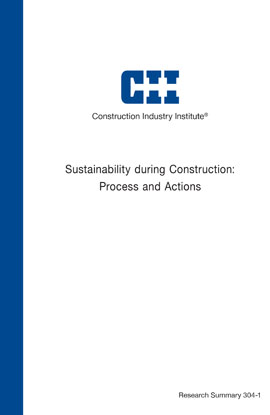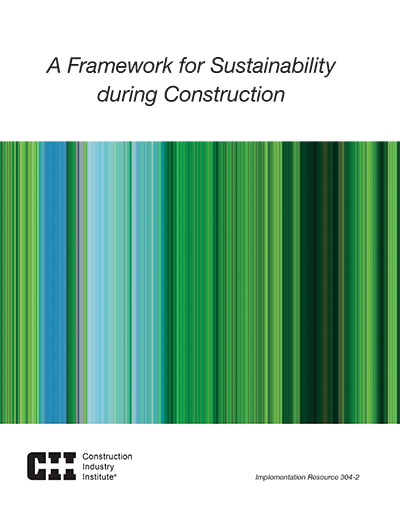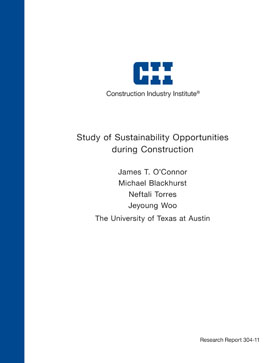
Sustainability during Construction: Process and Actions
Construction sustainability is the construction phase implementation of practices, strategies, and actions that address current and future environmental, social, and economic needs, while considering capital project safety, quality, cost, and schedule. Current literature on capital project sustainability focuses almost exclusively on the early concept planning and design phases. This research gap on sustainability in the construction phase shows the need for information, support tools, and guidance in this area. To fill this knowledge void, Research Team 304 identified 54 unique actions that project teams can take during construction to enhance overall project sustainability. The team classified, gauged, and modeled these construction phase sustainability actions (CPSAs) to allow a project team to implement them strategically.
In order to simplify the CPSA selection process, the research team created an implementation work process, a spreadsheet-based CPSA screening tool, and additional in-depth guidance for two selected CPSAs. The team also identified both input- and output-oriented construction sustainability metrics. Implementation Resource 304-2, A Framework for Sustainability During Construction, presents these support tools within a framework for integrating sustainability actions throughout the project construction phase. To make the CPSA screening tool more accessible to field practitioners, the team produced it in two formats: 1) the Excel®-based workbook format; and 2) a Web “app” tool format. Collectively, these tools will help project teams assess strategy, study implementation, and suggest quantifiable metrics for the construction phase of all their capital projects.
The research presents the recommended process for incorprating or integrating sustainability on capital projects during construction. Each of the seven distinct steps is important, regardless of construction contracting approach or division or responsibilties between owner and contractor. Implementing this process will be optimal in early construction planning stages.
Step 1 – Establish Objectives
Step 2 – Rank Top Actions
Step 3 – Select Actions
Step 4 – Plan Action Implementation
Step 5 – Implement Actions
Step 6 – Measure Outcomes
Step 7 – Improve Process
The research elaborates on step descriptions and associated implementation resources. (RS304-1, p. 9)
RT-304 identified 54 unique CPSAs that project teams can take during construction to enhance overall project sustainability. The CPSAs are organized into eight primary construction functions:
- Project Management
- Contracting
- Field Engineering
- Site Facilities and Operations
- Craft Labor Management
- Materials Management
- Construction Equipment Management
- Quality Management, Commissioning and Handover
Nearly two-thirds of the 54 CPSAs pertain to three construction functions: project management, field engineering, and site facilities and operations. The assessment identifies two common barriers to successful implementation for each CPSA. IR304-2 presents the entire CPSA catalog in its Appendix A, where the CPSAs are sequenced according to construction function. The research also provides a sample CPSA catalog entry. (RS304-1, p. 11)
Choosing from a catalog of 54 CPSAs may seem challenging to project teams seeking a limited number of CPASs for their projects. To meet this challenge, RT-304 developed a screening tool to help project managers determine the most applicable CPSAs for any given project. The screening tool solicits user input on project-specific sustainability priorities and general project characteristics, to generate a prioritized list of CPSAs. To process user input, the tool relies on tool-resident fixed data on CPSA sustainability impact types and magnitudes, along with CPSA benefit-leveraging conditions – variables covered in the CPSA catalog (RS304-1, p. 25).
One of the primary objectives of this research was the development of construction sustainability metrics. Such metrics can help project teams assess their sustainability implementation efforts or measure performance against set targets. They can also measure sustainability implementation progress over time. In general, metrics come in one of two forms: input-oriented and output-oriented metrics.
- Input metrics typically measure the breadth and/or extent of effort applied in the pursuit of an established goal.
- Output metrics focus on the actual achievement of one or more performance goals.
RT-304 developed the CPSA Implementation Index, an input metric, as a numerical measure of the breadth and extent of a project’s implementation for all 54 CPSAs. (RS304-1, p. 27 or IR304-2, p. 33)
Performance-oriented output metrics are generally preferable to resource- or process-oriented input metrics, and the research team identified a wide range of construction sustainability output metrics. Following are the seven most predominant output metrics (RS304-1, p. 28):
- Percentage of projects with sustainability performance section in project reports
- Cost savings
- Portion/volume of total waste recycled or diverted from a landfill
- Street value of recycled material
- Equipment environmental performance
- Size of carbon footprint from project
- Number of complaints from community, agency, or camp residents



